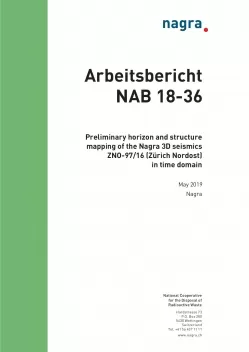
Arbeitsbericht NAB 18-36
Preliminary horizon and structure mapping of the Nagra 3D seismics ZNO-97/16 (Zürich Nordost) in time domain
In the context of the "Sachplan Geologische Tiefenlager" ("Sectoral Plan for Deep Geological Repositories"; SGT), Nagra is currently investigating three siting regions in northern Switzerland: Jura Ost, Nördlich Lägern and Zürich Nordost. As part of these investigations, Nagra carried out three 3D seismic surveys over the years 2015 to 2017 in each of the three areas, in addition to the already existing one, acquired 1997 in Zürich Nordost. This report summarises and illustrates the preliminary horizon and structure mapping of the newly available Nagra 3D seismics ZNO-97/16, covering the Zürich Nordost siting region (ZNO). It is a 53 km2 data cube consisting of seismic records from two different surveys acquired in 1996/97 and 2016. The two datasets were merged in the course of processing and provided to the interpretation team in this form.
The horizon and structure mapping of the ZNO-97/16 3D seismics presented here is carried out in time domain. It is considered preliminary as borehole interpretation control is currently limited to only one well, the pre-existing Benken borehole, and the refinement processing of the seismic data including depth migration is still ongoing.
The present report summarises the current status of the work and is intended to provide a preliminary structural overview of the siting region focusing on the Mesozoic sedimentary sequence and the larger-scale faults dissecting it. It is intended to serve various planning aspects within SGT Stage 3, most importantly those related to the deep borehole campaign in the ZNO siting region (e.g. the definition of drilling work programmes) and the basic scoping of underground access facilities.
The synthetic seismogram of the Benken borehole was revised during this study considering the newly processed 3D seismic data. During seismic-to-well tie, a correlation coefficient of about 70 % was achieved. Based on the seismic-to-well tie with the Benken borehole, eight seismic marker horizons were defined. The further interpretation work was carried out using the Petrel software suite. The horizon interpretation was first done largely manually on a so-called seedline grid consisting of every 5th in- and crossline of the seismic dataset. Fault interpretation was done in the same context, focusing on larger-scale faults with vertical throws of more than > 10 ms. The interpretation of fault traces was additionally guided by seismic attribute volumes and horizon slices that were calculated and processed as part of the project. The horizon interpretation was completed by applying autotracking algorithms.
Most of the defined marker horizons were found to be well traceable throughout the entire survey area. Notable exceptions include the Base Tertiary which cannot be tracked to surface, as indicated by geological maps pointing towards not yet fully resolved static correction in the area, and the Top Gipskeuper, which is affected by an apparent seismofacies change in the southeastern corner of the date cube. The marker horizons Base Malm, Top Opalinus Clay and Top Muschelkalk were also found difficult to interpret locally. Time thickness maps for some horizon intervals show variations which may point towards laterally changing sediment thicknesses possibly associated with changes in sedimentological facies. However, since the seismic data and their interpretation are currently only available in time domain, these indications must be treated with caution.
The main faults within the ZNO-97/16 survey area include the previously recognised Neuhausen Fault, the Wildensbuch Flexure, the Trüllikon Anticline, the Rafz – Marthalen Flexure and the Niderholz Structure Zone. The latter was confirmed to be structurally very complex featuring polygonal fault geometries and was not interpreted in detail during this study. One main structure was newly identified in the course of this interpretation and is defined here as the Uhwiesen Fault. It crosses the northern part of the siting region in a NW-SE direction (parallel to the Neuhausen Fault) and is mostly restricted to Triassic units, although defining its vertical extent has turned out to be difficult. Besides these structures defined by clear reflection discontinuities or flexures, the ZNO siting region was confirmed to be crossed by a number of NNE-SSW trending lineaments. These structures are associated with very minor vertical offsets (below the vertical resolution of the seismic data) and their tectonic significance remains to be further investigated.
Overall, the preliminary horizon and structure mapping of the ZNO-97/16 3D seismic largely confirms the principal structural characteristics of the siting region Zürich Nordost. Due to the fact that 3D seismics were already available for this siting region a comparison between the current mapping and previous seismic interpretation was possible. This comparison shows a very good agreement concerning the identification of the main structural elements. Differences concern the distribution of smaller-scale faults. They are inferred to be primarily related to varying fault mapping criteria. It is intended to critically review and improve these criteria in the course of the further seismic data analysis. Follow-up interpretations of the ZNO-97/16 3D seismic are foreseen to address seismofacies aspects and a more detailed interpretation of the identified but not yet kinematically analysed fault structures in the area of interest (for example the abovementioned lineaments and the peculiar Niderholz Structure Zone with its polygonal fault geometries). Another aspect that was deliberately not yet addressed by the 3D seismic mapping presented here concerns the seismic interpretation of the geological basement. These and other aspects will be further investigated in the later course of the SGT when the presented seismic interpretation will be further refined considering currently ongoing refinement processing and additional geological information from deep boreholes.
